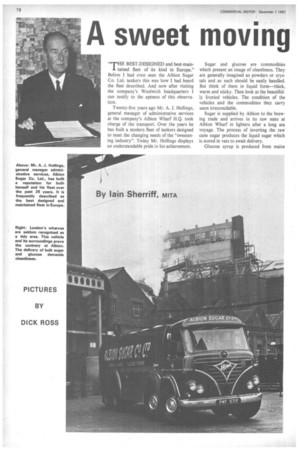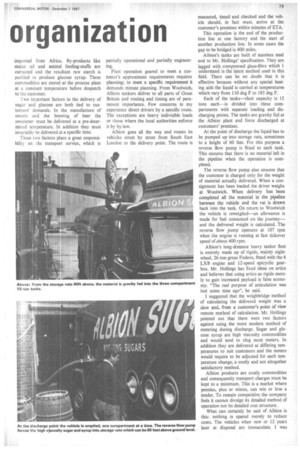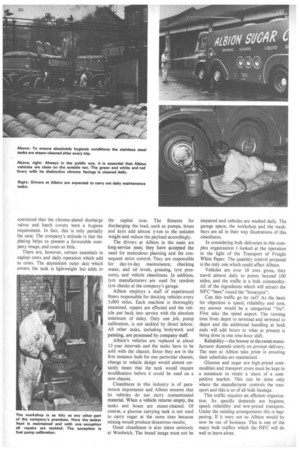A sweet moving
Page 80

Page 81

Page 82

If you've noticed an error in this article please click here to report it so we can fix it.
organization
"FrIHE BEST-DESIGNED and best-main
". tained fleet of its kind in Europe." Before I had even seen the Albion Sugar Co. Ltd. tankers this was how I had heard the fleet described. And now after visiting the company's Woolwich headquarters I can testify to the aptness of this observation.
Twenty-five years ago Mr. A. J. Hollings, general manager of administrative services at the company's Albion Wharf H.Q. took charge of the transport. Over the years he has built a modern fleet of tankers designed to meet the changing needs of the "sweetening industry". Today Mr. Hollings displays an understandable pride in his achievement. Sugar and glucose are commodities which present an image of cleanliness. They are generally imagined as powders or crystals and as such should be easily handled. But think of them in liquid form—thick, warm and sticky. Then look at the beautifully liveried vehicles. The condition of the vehicles and the commodities they carry seem irreconcilable.
Sugar is supplied by Albion to the brewing trade and arrives in its raw state at Albion Wharf in lighters after a long sea voyage. The process of inverting the raw cane sugar produces the liquid sugar which is stored in vats to await delivery.
Glucose syrup is produced from maize imported from Africa. By-products like maize oil and animal feeding-stuffs are extracted and the resultant raw starch is purified to produce glucose syrup. These commodities are stored at the process plant at a constant temperature before despatch to the customer.
Two important factors in the delivery of sugar and glucose are both tied to customers' demands. In the manufacture of sweets and the brewing of beer the sweetener must be delivered at a pre-determined temperature. In addition they must invariably be delivered at a specific time.
These two factors place a great responsibility on the transport service, which is partially operational and partially engineering.
Fleet operation geared to meet a customer's approximate requirements requires planning; to meet a specific requirement it demands minute planning. From Woolwich, Albion tankers deliver to all parts of Great Britain and routing and timing are of paramount importance. Few concerns in my experience direct drivers by a specific route. The exceptions are heavy indivisible loads or those where the local authorities enforce it by by-law.
Albion goes all the way and routes its vehicles street by street from South East London to the delivery point. The route is
measured, timed and checked and the vehicle should, in fact must, arrive at the customer's premises within minutes of ETA.
This operation is the end of the production line at one factory and the start of another production line. In some cases the gap to be bridged is 400 miles.
Albion's tanks are built of stainless steel and to Mr. Hollings' specification. They are lagged with compressed glass-fibre which I understand is the latest method used in this field. There can be no doubt that it is effective because without any special heating aids the liquid is carried at temperatures which vary from 110 deg F to 185 deg F.
Each of the tanks—their capacity is 15 tons each—is divided into three com
partments with separate loading and discharging points. The tanks are gravity fed at the Albion plant and force discharged at customers' premises.
At the point of discharge the liquid has to be pumped up into storage vats, sometimes to a height of 60 feet. For this purpose a reverse flow pump is fitted to each tank. This ensures that there is no material left in the pipeline when the operation is completed.
The reverse flow pump also ensures that the customer is charged only for the weight of material actually delivered. When a con signment has been loaded the driver weighs at Woolwich. When delivery has been completed all the material in the pipeline between the vehicle and the vat is drawn back into the tank. On return to Woolwich.
the vehicle is reweighed—an allowance is made for fuel consumed on the journey— and the delivered weight is calculated. The reverse flow pump operates at 107 rpm when the engine is running at fast tickover speed of about 400 rpm.
Albion's long-distance heavy tanker fleet is entirely made up of rigids, mainly eightwheel, 26-ton-gross Fodens, fitted with the 6 LX13 engine and 12-speed epicyclic gearbox. Mr. Hollings has fixed ideas on artics and believes that using artics as rigids merely to gain increased payload is false economy. "The real purpose of articulation was lost some time ago", he said.
I suggested that the weighbridge method of calculating the delivered weight was a slow and, from a customer's point of view remote method of calculation. Mr. Hollings pointed out that there were two factors against using the more modern method of metering during discharge. Sugar and glu cose syrup are high viscosity commodities and would tend to clog most meters. In addition they are delivered at differing temperatures to suit customers and the meters would require to be adjusted for each temperature change, a costly and not altogether satisfactory method.
Albion products are costly commodities and consequently transport charges must be
kept to a minimum. This is a market where pennies, plus or minus, can win or lose a tender. To remain competitive the company feels it cannot divulge its detailed method of operation nor its detailed cost structure.
What can certainly be said of Albion is this nothing is spared merely to reduce costs. The vehicles when new or 12 years later at disposal are immaculate. I was convinced that the chrome-plated discharge valves and hatch covers were a hygiene requirement. In fact, this is only partially the case. The company's attitude is that the plating helps to present a favourable company image, and costs so little.
There are, however, certain essentials in capital costs and daily operation which add to costs. The aluminium outer skin which covers the tank is lightweight but adds to the capital cost. The fitments for discharging the load, such as pumps, hoses and keys add almost fton to the unladen weight and reduce the payload accordingly.
The drivers at Albion in the main are long-service men; they have accepted the need for meticulous planning and the consequent strict control. They are responsible for day-to-day maintenance, checking water, and oil levels, greasing, tyre pressures, and vehicle cleanliness. In addition, tyre manufacturers are used for random tyre checks at the company's garage.
Albion employs a staff of experienced fitters responsible for docking vehicles every 5,000 miles. Each machine is thoroughly examined, repairs are effected and the vehicle put back into service with the absolute minimum of delay. Only one job, pump calibration, is not tackled by direct labour. All other tasks, including bodywork and painting, are processed by company staff.
Albion's vehicles are replaced at about 12-year intervals and the tanks have to be sold with the chassis. Since they are in the first instance built for one particular chassis, change in vehicle design would almost certainly mean that the tank would require modification before it could be used on a new chassis.
Cleanliness in this industry is of paramount importance and Albion ensures that its vehicles do not carry contaminated material. When a vehicle returns empty, the tanks and hoses are steam-cleaned. Of course, a glucose carrying tank is not used to carry sugar at the same time because mixing would produce disastrous results;
Outer cleanliness is also taken seriously at Woolwich. The brand image must not be impaired and vehicles are washed daily. The garage space, the workshop and the washbays are all in their way illustrations of this cleanliness.
In considering bulk deliveries in this complex organization I looked at the operation in the light of the Transport of Freight White Paper. The quantity control proposal is the only one which could affect Albion.
Vehicles are over 16 tons gross, they travel almost daily to points beyond 100 miles, and the traffic is a bulk commodity. All of the ingredients which will attract the NFC "bees" round the "honeypot".
Can this traffic go by rail? As the basis for objection is speed, reliability and cost, my answer would be a categorical "No". First take the speed aspect. The running time from depot to terminal and terminal to depot and the additional handling at both ends will add hours to what at present is being done in one nine-hour shift.
Reliability—the brewer or the sweet manufacturer depends utterly on prompt delivery. The men at Albion take pride in ensuring their schedules are maintained.
Glucose and sugar are high-priced commodities and transport costs must be kept to a minimum to retain a share of a competitive market. This can be done only where the manufacturer controls the transport and this is so of all bulk haulage.
This traffic requires an efficient organization. Its specific demands are hygiene, speed, reliability and low-priced transport. Under the existing arrangements this is happening. If it were not so Albion would by now be out of business. This is one of the many bulk traffics which the NFC will do well to leave alone.




























































































































































































